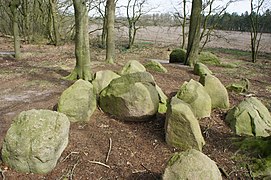Hünensteine from Steinkimmen
| Hünensteine from Steinkimmen Steinkimmen I, Steinkimmen II and Steinkimmen III | ||
|---|---|---|
|
Great stone grave Steinkimmen 2 |
||
|
|
||
| Coordinates | 53 ° 2 '41.8 " N , 8 ° 27' 2.8" E | |
| place | Steinkimmen , Lower Saxony , Germany | |
| Emergence | 3500 to 2800 BC Chr. | |
| Sprockhoff no. | 927-929 | |
The Hünensteine von Steinkimmen (also called Steinkimmen I, II and III ) are Neolithic passage graves with the Sprockhoff number. 927, 928 and 929. They originated between 3500 and 2800 BC. BC as megalithic systems of the funnel beaker culture (TBK). The passage grave is a form of Neolithic megalithic systems, which consists of a chamber and a structurally separated, lateral passage. This form is primarily found in Denmark, Germany and Scandinavia, as well as occasionally in France and the Netherlands. Neolithic monuments are an expression of the culture and ideology of Neolithic societies. Their origin and function are considered to be the hallmarks of social development.
The Hünensteine are located southeast of Steinkimmen , a district of Ganderkesee , in the Oldenburg district in Lower Saxony in the area of the streets "Alter Postweg" and "Bergedorfer Landstraße".
Hünensteine I
The shape of the approximately 18-meter-long chamber near the "Old Post Route" can still be seen. One of the cap stones she has survived measures 3.0 × 2.5 × 1.5 meters. It is a bit away from the complex. Traces of wedges can be seen on three stones that were driven into the boulders when the facility was destroyed. Six of these markings can be seen on the break lines of one. When setting up an information board we found a small copper rolls , arrowheads from flint and zerscherbte ceramics by which the plant is believed to have a so-called Emsländische chamber was v to the period from 3300 to 3000. In the period of the funnel beaker culture (TBK).
Hünensteine II
The Hünensteine 2 are located on a parking lot on Bergedorfer Landstrasse. The long, east-west-oriented chamber was presumably located in an oval enclosure. All 30 bearing stones of the chamber have been preserved, most of them still in situ . Of the original 12 capstones, only two are left. The middle capstone (in the area of the entrance), which is always attractive in the “Emländische Kammern”, is also in situ, as are the two end stones that mark the ends of the chamber. The chamber length is 22.5 meters. The chamber, which is somewhat untypical for this type of system, is not trapezoidal, but varies in width between 1.7 and 2.2 meters. The length of the enclosure, to which 14 stones can still be assigned, was about 28 and its width seven meters. The access on the south side is three meters long and one meter wide.
- Hünensteine from Steinkimmen
Hünensteine III
The Hünensteine 3 are located on a pond west of the Bergedorfer Landstrasse. This grave was destroyed at the end of the 18th century and the stones were used for the foundation of the mausoleum of Duchess Elisabeth at the Oldenburg Gertrudenfriedhof . Today there are 16 stones left, two or three of which were probably cap stones.
See also
- Nordic megalithic architecture
- The facilities are located on the street of the megalithic culture .
literature
- Anette Bußmann : Stone Age witnesses. Travel to the prehistory of northwest Germany. Isensee Verlag, Oldenburg 2009, ISBN 978-3-89995-619-1 , pp. 103-104.
- Mamoun Fansa : large stone graves between Weser and Ems. Isensee Verlag, Oldenburg 1992, ISBN 3-89442-118-5 , pp. 104-105.
- Ernst Sprockhoff : Atlas of the megalithic tombs Germany. Part 3: Lower Saxony - Westphalia. Rudolf Habelt Verlag, Bonn 1975, ISBN 3-7749-1326-9 , pp. 129-130.
Web links
- The Megalithic Portal: grave 1 (here listed as tomb 2) , tomb 2 (here listed as tomb 1) , tomb 3
- strahlen.org: grave 1 , grave 2 , grave 3
- steinzeugen.de: "Hünensteine 1-3", Steinkimmen
- cruptorix.nl: grave 1 , grave 2 , grave 3
- steinzeitreise.de: Large stone graves "Hünensteine" Steinkimmen
Individual evidence
- ↑ J. Müller In: Varia neolithica VI 2009 p. 15






